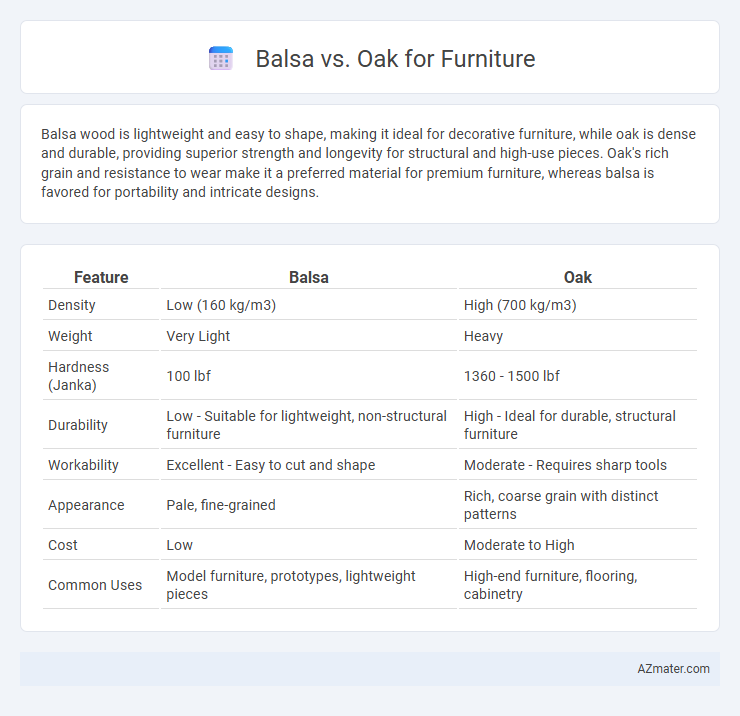Balsa wood is lightweight and easy to shape, making it ideal for decorative furniture, while oak is dense and durable, providing superior strength and longevity for structural and high-use pieces. Oak's rich grain and resistance to wear make it a preferred material for premium furniture, whereas balsa is favored for portability and intricate designs.
Table of Comparison
| Feature | Balsa | Oak |
|---|---|---|
| Density | Low (160 kg/m3) | High (700 kg/m3) |
| Weight | Very Light | Heavy |
| Hardness (Janka) | 100 lbf | 1360 - 1500 lbf |
| Durability | Low - Suitable for lightweight, non-structural furniture | High - Ideal for durable, structural furniture |
| Workability | Excellent - Easy to cut and shape | Moderate - Requires sharp tools |
| Appearance | Pale, fine-grained | Rich, coarse grain with distinct patterns |
| Cost | Low | Moderate to High |
| Common Uses | Model furniture, prototypes, lightweight pieces | High-end furniture, flooring, cabinetry |
Introduction to Balsa and Oak as Furniture Materials
Balsa wood, known for its exceptionally lightweight and soft texture, is often used in projects where weight reduction is critical, such as model making and prototype furniture. In contrast, oak is a dense, hardwood prized for its durability, strength, and attractive grain pattern, making it a preferred choice for long-lasting, sturdy furniture. Each wood's unique characteristics directly influence its suitability in furniture design, balancing aesthetics, weight, and structural requirements.
Physical Properties: Balsa vs Oak
Balsa wood is exceptionally lightweight, with a density of approximately 160 kg/m3, making it ideal for applications requiring easy handling and fast construction. Oak, by contrast, has a much higher density around 700 kg/m3, contributing to its strength, durability, and resistance to wear, which are essential for long-lasting furniture. The hardness of oak, measured by the Janka scale at about 1360 lbf, far exceeds balsa's 100 lbf, emphasizing oak's superior structural integrity in furniture design.
Durability and Strength Comparison
Oak wood exhibits superior durability and strength compared to balsa, making it a preferred choice for heavy-duty furniture applications. Oak's dense grain structure provides excellent resistance to wear, dents, and warping, ensuring long-lasting performance. Balsa, while extremely lightweight and easy to work with, sacrifices strength and is better suited for decorative or light-use furniture rather than structural components.
Weight Differences: Lightweight vs Sturdy
Balsa wood is significantly lighter than oak, making it ideal for furniture requiring easy portability and minimal weight. Oak offers a sturdy, dense composition that provides exceptional strength and durability, suitable for heavy-use furniture pieces. Choosing between balsa and oak depends on the balance needed between lightweight convenience and robust sturdiness.
Aesthetic Appeal: Grain, Color, and Finish
Balsa wood features a light, creamy color with a smooth, fine grain that creates a minimalist and modern aesthetic, ideal for sleek, contemporary furniture designs. Oak displays a richer, warm tone ranging from light to medium brown with a prominent, coarse grain pattern, offering a classic and timeless appeal that enhances traditional and rustic interiors. Both woods accept finishes well, with oak's grain becoming more pronounced under staining, while balsa's smooth texture allows for even coatings, highlighting its subtle beauty.
Workability and Ease of Crafting
Balsa wood is highly favored for furniture due to its exceptional workability, being soft and lightweight, which allows for easy cutting, shaping, and sanding even with basic tools. Oak, by contrast, is a hardwood known for its durability and strength, but it is harder to carve and shape, requiring more advanced tools and greater effort during crafting. Craftsmen often choose balsa for model-making and light furniture projects, while oak is preferred for heavy-duty pieces that demand longevity and sturdiness.
Cost and Availability of Balsa and Oak
Balsa wood is significantly less expensive than oak, making it a cost-effective choice for lightweight furniture projects, while oak commands a higher price due to its density and durability. Oak is widely available in North America and Europe, making it a common choice for traditional and high-end furniture manufacturing, whereas balsa is predominantly sourced from Central and South America and may have limited local availability. The widespread distribution of oak ensures consistent supply and pricing stability, whereas balsa's availability can fluctuate based on regional export conditions.
Environmental Impact and Sustainability
Balsa wood, known for its rapid growth and high carbon sequestration, offers a more sustainable option compared to oak, which grows significantly slower and requires more resources per cubic meter harvested. Balsa's low density reduces transportation emissions, while oak's dense hardwood demand often leads to deforestation and habitat loss, impacting biodiversity. Choosing balsa minimizes environmental footprint through renewable sourcing and faster forest regeneration, whereas oak furniture typically involves longer ecological recovery times.
Best Furniture Applications for Balsa and Oak
Balsa wood is ideal for lightweight furniture such as model-making, decorative panels, and prototypes due to its exceptional buoyancy and softness. Oak, renowned for its strength and durability, is best suited for heavy-use furniture like dining tables, chairs, and cabinetry requiring long-lasting sturdiness. The contrasting properties make balsa perfect for design flexibility, while oak excels in structural integrity and wear resistance.
Final Verdict: Choosing Between Balsa and Oak
Balsa wood is ideal for lightweight, easily sculpted furniture pieces requiring minimal strength, while oak offers exceptional durability, hardness, and resistance to wear, making it suitable for heavy-use furniture. Oak's dense grain and natural resistance to pests and moisture provide long-lasting performance unmatched by balsa. For furniture prioritizing strength and longevity, oak is the superior choice; balsa suits decorative or temporary projects where weight is a critical factor.

Infographic: Balsa vs Oak for Furniture
 azmater.com
azmater.com